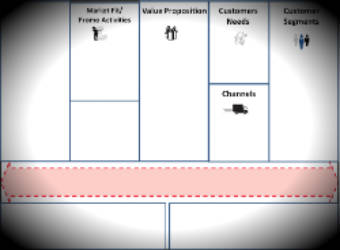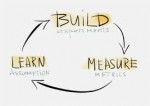
by Rita Baker | Feb 10, 2015 | Lean Startup
In the previous post I went over what the Minimum Viable Product marketing (MVP) plan can do for your company. Now, I will share with you the elements that are part of the MVP marketing plan.
The MVP marketing plan takes its inspiration from the Business Model Generation (BMG) canvas as well as Lean Startup methodology. It uses the canvas form of the BMG and shares some of the same elements. It is also used the same way with little sticky notes (texts or pictograms) to remind you of what you discussed with your team.
Each iteration of your MVP will require adjustments to your MVP marketing plan. Of course, the first one will be the longest to build as you will be starting from scratch.
Value Proposition
Your value proposition is defined as the benefits your customers can expect from your product or service. It is the heart of your marketing plan. Your value proposition will state how your customers will maximise their gains, minimise their pains and do their jobs (literally or figuratively) better with your product or service. Writing your value proposition is not always an easy task. If you are having a hard time with it I strongly suggest you take a look at Value Proposition Design from the authors of BMG.

 Customers Needs
Customers Needs
Identifying the customers’ needs, you are answering with your MVP, is essential to writing your value proposition. It is also normal and positive to refine your understanding of your customer needs from one plan iteration to the next. Your new findings will most likely impact most if not all of the other elements of the plan. This previous Techno Marketing blog post on understanding your customer needs can help.
 Customer Segments
Customer Segments
Your MVP marketing plan may be addressing one, a few, or all of your customer segments. The assumption here is that you have already identified the segments your business will be pursuing. Customer segmentation can be just as difficult, if not more, than writing your value proposition. There are hundreds if not thousands of marketing books that will try to teach you how to go about segmentation. Taken to its limits it is a science. However, if you are just starting up and marketing isn’t your thing, here is a little recipe that will help you get started with your segmentation. When you go out and talk to people, you assume will be interested by your product or service, put them into 3 groups:
- Super excited about your product and want to buy it right now
- Are interested in your product and want more information
- Listened to you politely, told you your idea was great and wished you luck
Discard the folks in groups 2 and 3 as well as the ones who told you to go fly a kite for this exercise. Analyse all the information you wrote down as well as the one you remember from your meetings with people in group 1. You will need at least 5-6 subjects in group 1 in order to segment (*). Try to find commonalities among a few of the subjects or characteristics that differentiate them from each other. The commonalities or characteristics could be
- How important certain of the pains you are trying to ease are to them
- How much value they place on the gains your product offers them
- How they go about doing the job you want to facilitate on a daily basis
Just remember you will be forming segments with these variables in the future. Hence you want them to be as easily measurable and identifiable as possible.
 Market fit and/or promotional activities
Market fit and/or promotional activities
This element of the plan includes different types of activities. If you are ready to start selling your product (even in pre-order mode) you will need to promote your company and product to do so. Your ‘’marketing team’’ will think of some promotional activities for each segment and this element is where you will keep track of what is going on at a given time. If you are not yet selling but you are either promoting your brand (maybe with potential VCs), elaborating a Kickstarter campaign, or doing some other promotional activity to get your product or product idea out in front of potential customers, this is also where you will keep track of those activities.
 Channels
Channels
This element identifies the distribution channels that will be impacted by your promotional activities. Whether it be the web, your sales reps or point of sales this element will help you keep track of who and how they will be impacted as well as any actions required with the channels due to your promotional activities.
The third post in this series will cover the five remaining elements of the MVP marketing plan.
(*) If you don’t have at least 5 persons in group 1, try with people that have a different profile or get someone who can communicate the value proposition better. If you have looked high and low and can’t find 5 persons excited about your product, abandon ship and try again with a different product/service idea.
EDIT – Sept. 2016 – Graphics

by Rita Baker | Feb 3, 2015 | Lean Startup
As I’m gaining experience helping companies market their minimum viable products (MVP) it is quite clear that the traditional marketing plan isn’t suited for the task.
Those of you who have read me in the past know I am a big fan of Business Model Generation, Lean Startup (hence the MVP) and Design Thinking for fast moving business environments.
I have looked at various marketing plan models that somewhat followed those lines of thinking. I tried using Ash Maurya’s Lean Canvas (based on the Business Model Generation canvas), which seemed like the better alternative, but it’s still not exactly what my clients needed to organise their marketing efforts. Hence I found myself adding boxes and crossing others out on the canvas according to my customer’s needs.
After almost a year, I am on my way to a marketing plan canvas that
- Lets the user cover all the marketing bases – it also acts as a checklist
- Allows a full view of what is currently going on marketing-wise
- Is easy to work with (as most users don’t have a marketing background)
- Minimises time investment in planning
- Can be adapted for different environments and situations
This canvas is not final. I don’t think it will ever be final. As it is more of an open toolbox than a tool, it will be used differently for different jobs. It will also be used differently by different people for the same job. As with the Business Model Generation canvas on which it is based, the innovation of the MVP marketing plan doesn’t come from the concepts it contains but rather an organisation of tried and true marketing concepts to better suit the realities of today’s start ups.
 Who has time for a marketing plan?
Who has time for a marketing plan?
Inherent to the Lean Startup methodology of MVPs is the break-neck speeds at which activities need to get done. In such environments it’s very easy to dismiss planning as a waste of time.
I won’t extol the virtues of business planning in this post as I’m certain you have heard them all. I will however share with you the benefits of a marketing plan when dealing specifically with MVPs that I have observed when helping start-ups.
Benefits of a marketing plan for a MVP
 Covering your bases
Covering your bases
Often early stages start-ups don’t have marketers to help them commercialise their MVPs and the marketing that needs to be done is not always clear. The MVP marketing plan can serve as a guide or check list to ensure the marketing bases have been covered. It doesn’t by any means replace deep marketing knowledge or a full marketing plan. It can however reassure you that you are not completely in left field when it comes to getting your MVP to market.

 A visible reminder and beacon
A visible reminder and beacon
The MVP marketing plan will be on the wall in your start-up space. You will be reminded every time you look at it of the what, when, where, why and how of your MVP every day. This helps with your focus as well as accelerates decision making when it comes to the MVP issues.
Some days, ok who am I kidding every day, entrepreneurs’ head spin with the sheer amount of information they have to process, issues they have to deal with, people they have to convince and decisions they need to make. It is very easy to lose sight of why you are launching your product and who you are doing it for.
The MVP marketing plan acts as a beacon to help you get back on the right track when you don’t know which way is up any longer.
 Gaining new understandings by changing your point of view
Gaining new understandings by changing your point of view
An entrepreneurial team I worked with who were at a standstill at their 4th MVP iteration found a new use for the MVP marketing plan. They chronologically aligned all their post-its (used in the multiple MVP marketing plan iterations they went through in 6 months) in each box in the plan. Simply by reorganising the display of this information they quickly identified a subtle shift in marketing strategy, which had gone unnoticed, after the onboarding of a new resource in the company. This shift had sent them on a wrong path on their 4th MVP iteration.
It also allowed them to realise that the recent delays they were experiencing on their schedule was due to a key resource that was not the one they had initially identified as the culprit.
Finally, as I walked by their reorganised MVP plan I was able to see that they had incorporated a few vanity metrics in their last MVP iteration. When I asked them why, they humbly admitted that with their last MVP iteration not doing as well as previous ones they used these metrics to boost their moral and that of their surroundings. Some soul searching ensued.
In the second post of this series, I will show you what the MVP marketing plan canvas looks like and how to use it.
EDIT Sept. 2016 – Graphics

by Rita Baker | Nov 19, 2014 | Lean Startup
You may have never heard of value proposition but if you ever needed to sell a product or service you definitely know what it is.
The authors of Value Proposition Design, the sister book to Business Model Generation, have a very succinct definition that I like. It defines the value proposition as the benefits your customers can expect from your product or service.
It’s so simple. Why write a whole book about it then? I can assure you from experience that while the definition of a value proposition may be simple, writing one for your own product or service is not.
PURPOSE OF A VALUE PROPOSITION
Helps you organise your thoughts and communicate to your markets
Putting your value proposition into words will help you gather in one place all of your top selling arguments. You will be using all or parts of it in most of your communications to your customers. It will speed up your content creation and provide guidance for it.
Creating your corporate pitch will be a breeze
Once you have nailed your value proposition down you will only need to adapt it to your audience, add other messages if need be, and practice your timing and delivery of it to create your pitch.
It’s your lighthouse on a stormy sea
Your value proposition will remind you that answering your customers’ needs with a product or service they value is what your business is all about. If your business starts to skid and can’t deliver on its value proposition, you know corrective measures are necessary.
THE OLD VALUE PROPOSITION
Value propositions are not new. The way we use to define them gave equal weight to the product, the market segment and the industry. The value proposition was the answer to the following three questions.
- What is your product or service?
- Who is it for?
- Why is it better than your competitors’ offering?
A value proposition in the ‘90s would have looked like this.
Palm Pilot. The electronic pocket agenda, for busy professionals, that won’t weigh you down.
THE NEW VALUE PROPOSITION
Today, market segments are getting more and more granular. The competitive environment you operate in is changing much more rapidly. Focusing on market segments and competitors make writing your value proposition the old way a less precise exercise and a recurring task.
The approach suggested by the Value Proposition Design authors is better suited to today’s market realities.
It focuses on the value your product brings to answering a customers’ specific need. You only adjust your value proposition when the need changes. Which is a good thing given you will also need to change your product or service at this juncture if you want to stay in business. This way of creating your value proposition brings it all back to the customer’s need and positioning your offer against it.
Designing your value proposition now requires you to dig in order to understand your customers’ pains. What gains they expect as well as how they will interact with your product or service. This information will then allow you to analyse what pain relievers you offer them. The level of gain your product or service can bring them. It will also give you insight into how else your customers are answering the need you are addressing. This vantage point allows you a broader vision of your competitive environment by not restricting it to your industry competitors.
 Source: Osterwalder A., Pigneur Y., et Al. – Value Proposition Design – Wiley – 2014 – xxv+290p
Source: Osterwalder A., Pigneur Y., et Al. – Value Proposition Design – Wiley – 2014 – xxv+290p
You can click on the above image to download a more detailed and free version of the Value Proposition canvas on the Strategyzer site.
An example of a good value proposition today would be:
Unbounce. Build, publish and A/B test your landing pages without I.T. Increase the ROI of your marketing campaigns
This value proposition talks to the jobs (building, publishing and A/B testing landing pages), the pains (having to ask and wait for the IT department to do the pages), and the gains (increasing campaigns ROI) their customers care about.
There are other methodologies out there to help you create your value proposition. Whichever one you use, make sure it is suited to your reality. The Value Proposition Design method is particularly suited for companies operating in environments where markets can effectively be micro-segmented and the environment evolves rapidly.
A value proposition is very much like a macro or template you create when you have a repetitive task. It may take some effort to build but it will bring you high returns on the time you save and act as a guide in your every day work.

by Rita Baker | Sep 16, 2014 | Lean Startup
What is web analytics?
Aside from being scary for some, web analytics is the capture, analysis and reporting of web data from any type of platform (computer, mobile, clothing, etc.). A growing number of small companies now use web analytics. However, unlike big businesses, not all of them do. The availability of multiple free applications, of excellent quality, certainly has helped the adoption rate. It has yet to convince however many of small businesses to make the jump(1).
Do you need it?
If any significant amount of your sales comes directly or indirectly from the web, you definitely need to master web analytics.
If any of your business goals are tributary to your web presence you need to have, at the very least, a basic understanding of web analytics.
Should I let my IT department take care of it?
No more than you let IT take care of your accounting because you are using accounting software. Your IT team can play a supporting role if more complex coding is required to track data from your website or other platforms. In order to know who should have this responsibility in your company you need to look at the objectives you are trying to reach with your web presence. The responsibility can be shared if more than one department have goals attributed to them that are significantly impacted by your web presence.
If you are running an online business, just about every goal in your company will be tied directly or indirectly to your web presence. Hence, the CEO should be the person responsible for web analytics and can delegate to each department the care of appropriate metrics.
To the other extreme, if your web presence’s only goals are to inform and maintain your image the team responsible for communication can take the lead.

What is the minimum I need to know?
The best way to learn web analytics is simply to hook up one of the many free applications such as Google Analytics to your website, via coding or a plug-in, and familiarize yourself with the application. You (or the person that will be responsible on your team) will quickly get a feel for the basic statistics.
Basic information is interesting but not always useful unless tied to a specific goal.
Learning how to set goals in your application is your next step. This can easily be done by using one of the multiple online training resources available. Google has an entire web analytics course on Youtube that is broken down in convenient modules.
I advertise on the web
Advertising on the web (or anywhere for that matter) without controlling how much revenue the ads bring in is akin to burning your money. Web analytics of advertising campaigns increases the level of complexity and will require a trained resource. If you run frequent campaigns consider training an internal resource.
I run an online business
If you run an online business, web analytics is as important as your accounting. Ideally both your analytics and accounting software should be integrated. Knowing only the basics won’t get you very far. I would strongly suggest that your business model identifies web analytics as a key activity and your platform as a key resource from the start. Put the necessary efforts to translate your business goals into data that will be actionable, accessible and auditable. Dedicate the best internal resources you can afford to ensure that the data stays relevant, is of the best possible quality, and flows constantly.
If you need a web presence of any kind to run your business then web analytics is for you. The efforts you put into it depend on what your web presence brings to your bottom line.
(1): My observations suggest that the adoption rate for web analytics application for small businesses in Canada probably hovers around 20-30%. The rate would however be most likely above 50% for small companies in the software sector.

by Rita Baker | Sep 8, 2014 | Lean Startup
Eric Ries wrote Lean Startup: How Today’s Entrepreneurs Use Continuous Innovation to Create Radically Successful Business in 2011 and sparked an entire movement. Lean Startup is a methodology or, some may even say, a philosophy based on ideas from lean manufacturing and agile product development. Ideas such as minimizing waste through small batches, getting to market quickly and ensuring that all tasks accomplished in a company must benefit the customers.
Although the author’s experiences that led to Lean Startup are mostly in software start-ups, the concepts can be applied to organizations of all sizes in all sectors. If you haven’t read it attentively yet I strongly urge you to. It is one of the most pertinent and content rich books I’ve read in a long while.
The Good
It’s easy enough to understand the concepts. You build a minimum viable product (MVP), the equivalent of the small batch in lean manufacturing. You send it out to market quickly using agile development techniques. You measure how well it does with metrics that are actionable, accessible and auditable. You learn from the information you just gathered. You adjust your aim or you change your entire strategy (pivoting) if necessary. Then you start the cycle again aiming for the perfect product/market fit.

It will get your start-up to be profitable faster. You won’t be spending a year or two developing a product that the market has zero or not enough interest in to make it profitable.
It also promotes the idea that rigorous management, based on a sound dashboard, is a winning strategy. So many start-ups, managed solely on instincts, go round in circles and waste resources.
It makes implicit the notion that companies, products and strategies are not set in stone but fluid. The Lean Startup model pushes everyone in the organization to adapt constantly.
This type of agile, efficient and adaptable model is what is needed to answer the demands of today’s fast changing markets where customers and consumers hold the bigger end of the stick.
The Bad
Although the concept is easy to understand, putting it into practice is difficult, very difficult.
Figuring out what exactly is a minimum viable product when you are still not sure of what the market wants is not a science, it’s an art. Hence you need market artists that have a ‘’sense’’ of what the market wants. You do not want to spend precious time over developing your product nor delivering such a shoddy one that you kill your reputation before your company even takes off.
Figuring out which metrics to use for your learning curve and how to translate them into the right questions to ask is not easy but it’s doable. Finding potential target customers in large enough numbers, at every iteration of your product, to give you their feedback is pretty much mission impossible for most start-ups. Hence you need a budget (a hefty one at that) to outsource this part if you want to do it right.
Learning is easy enough for most people. Adapting to an Nth change of strategy (pivoting) within a short period is not, especially if you are part of a team. The larger the team, the harder it is to change your strategy. Unless you are equipped to deal with the strong emotional reactions significant pivoting generates you could, at best, damage morale and at worst lose key players.
The Ugly
The Lean Startup model may give the impression that anyone can be an entrepreneur and pump out an AirBnB or Uber. The reality is very different. Starting a company from scratch is not as easy as following a 1-2-3 recipe. It requires certain aptitudes and predispositions that most people don’t have. Ask any seasoned venture capitalist. They will tell you that, once the basics are covered, what they look for they find in their interactions with the entrepreneurs themselves. Entrepreneurs have a certain attitude that VCs can spot a mile away.
Finally, and this is a point that Eric Ries himself mentions, is the tendency most of us have to, for the sake of doing things quickly, apply a proven recipe without understanding its goals and where it stems from. Applying the build-measure- learn model or developing a MVP without understanding the basic ideology behind lean is a great recipe for failure. As illustrated by some critics of Lean Startup forecasting that the world is about to witness an onset of defective products stemming from start-ups launching their minimum viable products.
Lean Startup is not a magical recipe that, if applied rigorously, will yield successful start-ups without fail. Like any other methodology, using it blindly without proper questioning, perspective or adapting it to your environment, is never a good idea. Lean Startup is, however, a flexible experience-based methodology adapted to today’s market realities that will definitely increase the chances of success of any project.

by Rita Baker | Jul 1, 2014 | Lean Startup
(Utiliser le traducteur à droite ou au bas du texte pour sélectionner une autre langue)
As we saw in TechnoMarketing’s previous post, business models that currently make the most sense marketing-wise are ones that focus on understanding customers’ changing needs and getting solutions to market quickly and efficiently.
Such business models will have to:
- receive, process and circulate efficiently a constant flow of information,
- remove corporate silo walls or make them completely permeable,
- ensure an unimpeded flow of ideas,
- make the most of their human resources qualifications,
- minimize permission levels and
- organize work to quickly answer market requirements,
Taking inspiration from design thinking process as well as agile product development processes can take us a long way into answering those needs.
Design Thinking
Design thinking is, in short, a multi-step process paired with a given tool box that can be applied to any situation where a creative solution is required to solve a problem. Above all it is a human-centric process both in methodology (in takes into account human nature and human interactions) and in focus (it is centered on customer/user experience).
The major steps involved in design thinking are:
- Discovery – unleash the minds. Let the ideas/information flow from all sources with no barriers.
- Acquiring knowledge – When the problem is better defined and embryos of solutions emerge dig deeper to acquire a better understanding of the solutions
- Iterative experimentation/feedback loop – Implement the solutions that were identified in small iterative steps. Get customer/user feedback at every step and go back and correct if necessary.
Agile product development
Agile product development is a set of processes that allow development of a solution in the fastest and most efficient way possible. Scrums, fast stand-up meetings, are one of the core processes of agile product development. Scrums:
- remove corporate silo walls,
- use an iterative process,
- create environments where exchanging information and ideas is core and,
- focus on getting a product/service out the door fast.
A future post will delve into bringing together design thinking and agile product development to create a framework for ensuring lean agile selling machines.

![]() Customer Segments
Customer Segments Market fit and/or promotional activities
Market fit and/or promotional activities![]() Channels
Channels

 Customers Needs
Customers Needs
 Who has time for a marketing plan?
Who has time for a marketing plan? Covering your bases
Covering your bases
 A visible reminder and beacon
A visible reminder and beacon Gaining new understandings by changing your point of view
Gaining new understandings by changing your point of view





